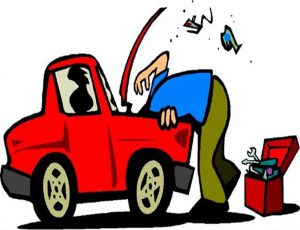How can I make more money in my business?
7 Rules for making more money and profit in business

Even profitable businesses go bankrupt from time to time
The second of The 7 Big Questions of Small Business about building a beautiful business and life: How can I make more profit and generate more cash flow?
I believe the question about making profit and generating cash flow is even more important than the growth question because I have seen many businesses go bankrupt while they were growing. Business growth only makes sense if you end up with more money in your bank account as a result. A business that doesn’t make profit and generate cash flow is a hobby.
These are the 7 most important rules about making and keeping money in your business.
Skip ahead to each of the 7 Rules:
- No profit, no business, but profit is not the point of it all.
- Pricing is key, but competing on price is a dog’s game.
- The 80/20 Rule: Some customers are profitable, and some are not.
- Cashflow is King: The Rule of the Three C’s.
- Profit is not cash: Understand the difference.
- Breakeven: The Rule of 4 times.
- Numbers equal control: Fingers crossed no longer.
The 7 Big Questions of Small Business
This page is all about the first of the 7 Big Questions of Small Business about building a beautiful business and life. The Big Questions are:
- How can I Grow my business? (this page)
- How can I make more Money in my business?
- How can I get Unstuck in my business?
- How can I create a better Work-life-balance in my business?
- How can I become a better Leader in my business?
- How can make my Family Business work better?
- How can find the right support in my business?
Follow the link to an in-depth explanation of how I help business owners in the Fun in Business program to build their own beautiful businesses and lives. There is also a page with a full explanation of all of my business life coaching programs.
1. No profit, no business, but profit is not the point of it all
John Mackey is the founder of a large international chain of organic supermarkets called Wholefoods Markets. The company has been highly profitable ever since John founded it in the early eighties and it has paid a dividend to its shareholders every year of its existence. Amazon purchased the company for untold billions of dollars and John Mackey is now one of the world’s richest people. John clearly knows a thing or two about building great businesses and about making money.
John Mackey also wrote a book, however, called Conscious Capitalism and in it, he says something that made the penny drop for me. He says this:
“Thinking that the Purpose of business is to make money is as silly as thinking that the Purpose of people is to eat food. We need to eat food, we eat food all our lives, and good food is better than bad food and without food we die, but eating food is not the reason we exist. We eat food so we can make good on our Purpose in life”.
John says it’s the same with business and money. The business must make money and profit and generate cash flow (and plenty of it!), but only so that it can make good on its greater purpose.
So, let’s be clear about that: making money is the means to an end, and without profit and cash flow, the business cannot perform its function.
Download my Free Guide to finding the right coach to help you make more money.
All about Profit here:
-
Making Money from Death and Hamburgers
How to make money in your business model. I’d hate to live in a world where 18 yr old undertakers ask me:: Do you want roses with that?Read more Making Money from Death and Hamburgers ›
-
Gross Margin, Competition, Growth and the Red Queen problem.
Gross Margin, is the key number every business owner should watch like a hawk. Consistent focus on Gross profit is how you build a Great Business.Read more Gross Margin, Competition, Growth and the Red Queen problem. ›
-
Future Proofing Your Business With Profit
Profit is good. Profit is fun. Profit makes us smile. A business must make profit or it’s a hobby instead of a business. But why, actually, is that?Read more Future Proofing Your Business With Profit ›
All articles on this site about Profit, Cash and Purpose
More about Profit and Purpose elsewhere:
2. Pricing is key, but competing on price is a dog’s game.
Everyone can sell cheap. It takes no special skill or approach to sell cheap. It takes incredible skill and focus to be the cheapest, make a profit and be around for the long haul. Very few businesses can do so consistently. The only three I know of are Aldi, Ikea and Walmart. I’m sure there are others but they’re few and far between.
If you make low pricing your main differentiator and competitive advantage then you better be the most disciplined and focused business out there because there will always be someone knocking on the door undercutting you and you’ll constantly struggle to make enough money to survive, let alone build a beautiful business and life. Competing on price is simply a dog’s game.
Instead, ask yourself what you need to do to be the most expensive. Raise your prices and see what it takes to sell at higher prices. What else can you compete on? Remember, a beautiful business and life is so much easier to achieve with high margins.
Download my Free Guide to finding the right coach to help you make more money.
More about competing on price here:
-
The trouble with value and how to price it
Value based pricing is a way to price your services based on the value you provide, not on the time, The model gives food for thought.Read more The trouble with value and how to price it ›
More about pricing and value elsewhere:
- The first steps to sound financial management of your business
- How to make more money in business
- 1001 Business Bedtime Stories: Amanda and financial management
- The problem with value and pricing
3. 80/20: Some customers are profitable, and some are not

You might have heard of the Pareto Principle or the 80/20 rule. This rule can be applied in many situations, but there is no more appropriate topic than a business and its customers.
I can just about guarantee that if you were to run a report listing all your customers on a continuum with maximum profit and cash flow at one end of the scale down to least profit and cash flow (or even loss) at the other end, expressed in dollars, you will find there is a small bunch of customers at either end. There is a small group of customers who you make by far
most of your profit from, and equally, there is a small group of customers who cost you most of your money.
The problem is that most small businesses can’t easily run a report like that, but I can tell you it’s worth spending some time figuring it out or buying the software that makes it straightforward.
You will be shocked when you find out how much effort gets wasted on customers who keep you busy but don’t make you any money. Equally, you’ll realise how urgent it is to give more attention to the customers who bring in the majority of your money (because they might leave if you don’t!).
More about the 80/20 rule and customers here:
4. Cashflow is King: The Rule of the Three C’s.
In my days as a builder, a recurring problem was not finishing the jobs 100%. Sometimes for months, we’d leave a few defects outstanding because they were small and we had moved on to the next project. However, that meant we couldn’t collect the final invoice, sometimes for months. In other businesses, I see that people finish the work, but wait until the end of the month or sometimes even longer before they invoice the client.
Finally, most small businesses do not have a simple and consistent collection system. These three factors mean that your business is functioning as a bank for your customers. Your money is in their bank account and it’s of no use to you there. You must then constantly rob Peter to pay Paul, you can’t take advantage of early payment discounts from your suppliers and when your business is in growth mode, the problem compounds exponentially.
It’s even true that you’re cheating your customers by not completing, invoicing or collecting. Your customers want nothing more than to have their work done quickly, and when the work is completed well, your clients feel they are in your debt, and they want to remove that feeling as soon as possible. With every day that passes, that feeling of indebtedness changes and if they don’t receive your invoice until a week or a month later, they’re not so keen to pay you anymore.
Download my Free Guide to finding the right coach to help you make more money.
More about making money and cashflow here:
-
10 Tips for Better Finance Management in Your Business
One of the biggest mistakes rookie entrepreneurs make is failing to separate their personal and business financesRead more 10 Tips for Better Finance Management in Your Business ›
-
How much should I pay myself in my business?
A big factor in your profitability, is what you pay yourself as the business owner. Why does it matter what you pay yourself?Read more How much should I pay myself in my business? ›
-
Ten simple strategies to make more money in your business (plus a bonus)
Making money in your business isn’t rocket science: Just bring in more money than you spend. Here are the ten key strategies to do just that.Read more Ten simple strategies to make more money in your business (plus a bonus) ›
All about money and cashflow on this site
More about making money and cashflow elsewhere:
- 5 Ways to improve your cash flow in INC magazine
- 1001 Business Bedtime Stories; Vivienne and cash-flow
- How to get paid in your business
5. Profit is not Cash: Understand the difference

As I mentioned above, many businesses fall over even though they make a profit and grow. I also mentioned the compounding problem of growth. Here is a super-simplified example:
Let’s say you start in month 1 with a bank account balance of $1,000. You sell $1000 worth of stuff this month and after expenses, you have $100 leftover. That should mean you are $100 better off at the end of the month than you were at the beginning.
- However, if you’ve only collected $500 of that $1,000 in month 1 and the balance follows the month after, you’ll be $400 worse off at the end of month 1 than you were at the beginning. The bank account balance at the start of month 2 is now $600.
- Now, if in the next month you grow 20%, sell $1,200 and make the same profit percentage (10%), you will have made a total of $220 ($100 plus $120) profit by the end of month 2.
- We’ll assume that you collect at the same level (50% in the month and the rest follows the month after). So, the starting balance at month 2 is $600 plus the remainder of the collections from month 1, making $1,100. Deducting the expenses of month 2 ($1,080) leaves a balance of $20 plus collections for the month of $600, so your balance at the end of month 2 is $620. In other words, after 2 months of profitable and growing trading, you’ve gone backward by $380 – and that’s if everyone pays within payment terms. If only 5% of your customers are late payers, you will go back even further at the end of month 2 (and so on).
This is a highly simplified worked example, but it demonstrates the principle precisely. For this reason, in a growing business, you must give at least equal attention to cash and profit all the time. You could argue that cash is even more important than profit for two reasons:
- You can continue to run a business as long as you have the cash to pay the bills. There are many examples of big businesses that operated for many years without making profit, but who didn’t run out of cash (Amazon is one such example, and Tesla seems to be another current example).
- Profit can increase your cash stress because more profit leads to paying more tax and tax simply sucks cash out of your business.
Download my Free Guide to finding the right coach for you.
More about profit and cash here:
- Profits are a liability; what do you want for Christmas?
- Fun with financial management, Small Business Masterminds webinar
- Why cash is more important than profit
- The one thing all great business owners have in common
- Cash and profit on Linkedin
6. Breakeven: The Rule of 4 times
One of the most important things I do with new clients is to find their breakeven.
Breakeven is the number of dollars you must sell every month (or every day, week or year) to pay all the bills for that month. In other words, what does it cost to open the doors and turn on the lights? I find that the simplest way to establish your breakeven is this:
- Look at last year’s profit and loss (P&L) statement and find the total of all the overheads, fixed costs, rent, insurances, electricity, marketing costs, subscriptions, etc. Add to this the monthly repayments of loans and lease payments. Now divide that number by 12. This is the amount of gross profit that the business must generate every month, for 12 months of the year.
- By looking at the P&L for last year (or any other representative period), you’ll be able to see what percentage of revenue your gross profit amounts to. For argument’s sake, let’s say your monthly overheads are $20,000 and that, in the past year, your gross profit has been 30% of revenue. Now we can find out how much revenue you need to make to break even by dividing overheads by gross profit to calculate revenue. In this example, it would be $20,000/0.3 = $66,666.00. In other words, based on last year’s figures with a margin for error and inflation of 5% added, you have to sell $70,000 of your products or services every month.
But that’s not the end of the story. In order to survive and break even, you must hit this number four times every month:
- You must sell $70,000 every month.
- You must produce $70,000 worth of goods or services every month.
- You must invoice $70,000 every month.
- You must collect $70,000 into your bank account every month.
If you miss out by even $1,000 on any one of those four in any month, you’ll have to make up for that $1,000 in the month after.
By introducing this simple discipline, your business and life will never look the same again. By the way, keep in mind that I’ve been ignoring profit in this topic. Obviously, you must make a profit as well, but first, you must instil the discipline of hitting your breakeven four times every month (at least!).
More about breakeven here:
- There’s one number we all forget about
- Breakeven worked example
- Do the numbers really matter?
- Predict the future by monitoring this key number
7. Numbers equal control: Fingers crossed no longer?

The breakeven number I talked about above is one of those key numbers, but there are more. Bank balance is a key number. So is gross profit and aged debtors. Then there are various financial ratios, such as the gross profit percentage and ratios like the “debtor days ratio” and the “liquidity ratio”.
Besides financial numbers and ratios, there are many other numbers and ratios in a business that you need to keep an eye on. For example, the number of enquiries in the past month, the conversion rate, average job value, the average sale, warranty returns, customer satisfaction… you name it!
A client of mine who has a furniture removals business knows that he needs to keep a keen eye on his removalist’s wages as a percentage of total sales. If he spends more than 60% of sales on the wages of his boys, he knows he’s not managed the work schedule well enough.
Your business will have its own specific numbers and ratios that can tell you a lot about the health of your business. I often talk about the mailboat report with my clients:
- Imagine you are banished to a deserted island in the Pacific, without a mobile phone or email, and the only information you can get about your business is a single sheet of paper delivered by the mailboat every week.
- What numbers would have to be on that single sheet of paper to tell you precisely what you needed to know about the health of your business, so you could send immediate instructions back with the mailboat?
Download my Free Guide to finding the right coach to help you make more money.
All about making money and numbers on this site:
-
Highly Chilled Habit #3: Be on top of the Numbers
How to keep your fingers on the pulse of the key indicators of the health of your business every week and month, to grow with confidence.Read more Highly Chilled Habit #3: Be on top of the Numbers ›
-
5 Things to Master in your Small Business this year
The 5 big things to focus on for the new year to build and grow your business. If you want to build a beautiful business in any year, focus on these 5Read more 5 Things to Master in your Small Business this year ›
-
Driving your business forward by getting under the bonnet
KPI’s Numbers, Ratios, Dashboards. How do you get to hold your fingers on the pulse of the key indicators of the health of your business?Read more Driving your business forward by getting under the bonnet ›
More about numbers elsewhere:
- How to grow your business with your finger on the pulse, podcast
- Driving your business forward by getting under the bonnet
- The Ten Priorities: Financial Management
- The 5 P’s for your business in 2017 (and beyond)
- Financial management for fun and profit Small Business Masterminds webinar
- Business is all about the numbers
- What numbers drive your business (Rick Polito)
Conclusion, It’s common sense… isn’t it?
All of the above probably sounds like common sense. And it is, there’s probably not a lot you didn’t already know. Profit and cash flow are not inherently complicated concepts to understand. But just like with dieting, we mostly know what we need to know to lose weight (but look at me!!), the trick is in the implementation. That’s where external support comes in and where I and people like me can have a valuable role and make a difference.
I’ve written a lot more about coaching, mentoring and finding the right support in your business all through this website.
Download my Free Guide to finding the right coach to help you make more money.
I believe the question about making profit and generating cash flow is even more important than the growth question because I have seen many businesses go bankrupt while they were growing.
Business growth only makes sense if you end up with more money in your bank account as a result. A business that doesn’t make profit and generate cash flow is a hobby.
These are the 7 most important rules about making and keeping money in your business.
1. No profit, no business, but profit is not the point of it all.
2. Pricing is key, but competing on price is a dog’s game.
3. The 80/20 Rule: Some customers are profitable, and some are not.
4. Cashflow is King: The Rule of the Three C’s.
5. Profit is not cash: Understand the difference.
6. Breakeven: The Rule of 4 times.
7. Numbers equal control: Fingers crossed no longer.










